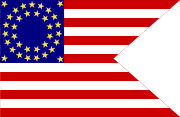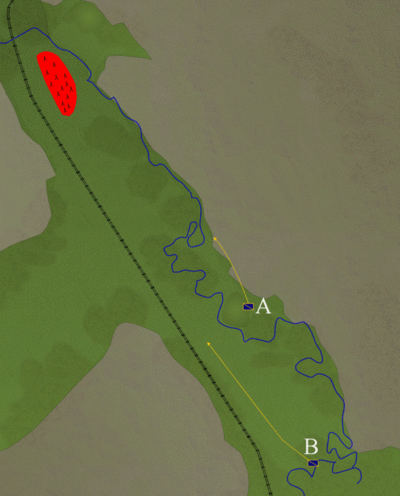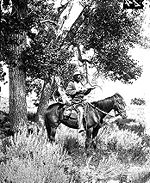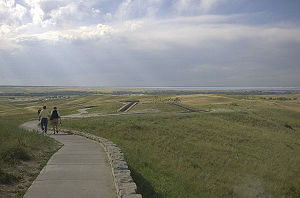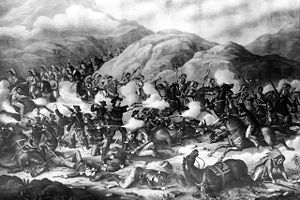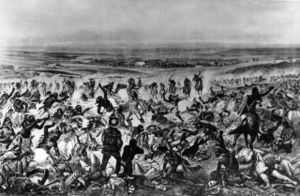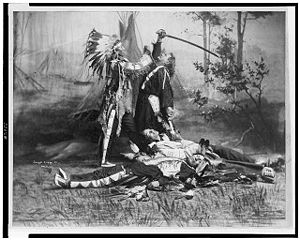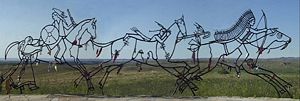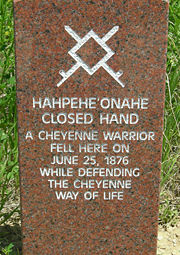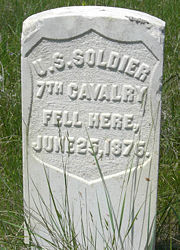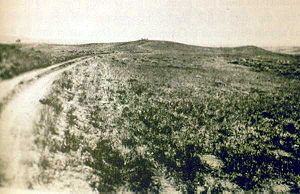Battle of the Little Bighorn
2008/9 Schools Wikipedia Selection. Related subjects: Pre 1900 Military
Coordinates:
|
||||||||||||||||||||||||||||||
|
||||||||||||||||||||||||||||||
The Battle of the Little Bighorn—also known as Custer's Last Stand, and, in the parlance of the relevant Native Americans, the Battle of the Greasy Grass—was an armed engagement between a Lakota- Northern Cheyenne combined force and the 7th Cavalry of the United States Army. It occurred between June 25 and June 26, 1876, near the Little Bighorn River in the eastern Montana Territory.
The battle was the most famous action of the Indian Wars, and was a remarkable victory for the Lakota and Northern Cheyenne, led by Sitting Bull. The U.S. Seventh Cavalry, including a column of seven-hundred men led by George Armstrong Custer, was defeated; five of the Seventh's companies were annihilated and Custer himself was killed in the engagement along with two of his brothers and a brother-in-law. The battle, however, was not the highest infliction of casualties by Native Americans against U.S. forces. That record was set in 1791 at the Battle of the Wabash.
Prelude to the Battle of Little Bighorn
After the 1875 Sun Dance alliance, made by Sitting Bull between the Lakota and Cheyenne, thousands of Indians had slipped away from their reservations through early 1876. Military officials planned a summer campaign to corral them and force them back to the reservations, using both infantry and cavalry in three expeditions:
Col. John Gibbon's column of six companies (A, B, E, H, I, and K) of the 7th Infantry and four (F, G, H, and L) of the 2nd Cavalry marched east from Fort Ellis in western Montana on March 30, patrolling the Yellowstone River.
Brig. Gen. George Crook's column of ten companies (A, B, C, D, E, F, G, I, L, and M) of the 3rd Cavalry, five (A, B, D, E, and I) of the 2nd Cavalry, two companies (D and F) of the 4th Infantry, and three (C, G, and H) of the 9th Infantry, moved north from Fort Fetterman in the Wyoming Territory on May 29, marching toward the Powder River area.
Brig. Gen. Alfred Terry's command (the entire 7th Cavalry; Companies C and G, 17th U.S. Infantry; and the Gatling gun detachment of the 20th Infantry) departed westward from Fort Abraham Lincoln in the Dakota Territory on May 17. They were accompanied by teamsters and packers with 150 wagons and a large contingent of pack mules. Companies C, D, and I, 6th U.S. Infantry, moved up the Yellowstone from Fort Buford on the Missouri River to set up a supply depot, and joined Terry on May 29 at the mouth of the Powder River.
The coordination and planning went awry on June 17 when Crook's column was delayed after the Battle of the Rosebud. Surprised and, according to some accounts, astonished by the unusually large numbers of Indians faced in the battle, Crook was essentially defeated in battle and forced to stop and regroup. Unaware of Crook's battle, Gibbon and Terry proceeded, joining forces in late June near the mouth of the Rosebud River. They formulated a plan, based on the discovery of a large Indian trail on June 15, that called for Custer's regiment to proceed up the Rosebud River, while Terry and Gibbon's united columns would move towards the Bighorn and Little Bighorn rivers. The officers hoped to trap the Indian village between these two forces. The 7th Cavalry split from the remainder of the Terry column on June 22 and began a rapid pursuit along the trail. Custer was offered the use of the Gatling guns but declined, saying they would slow his command. He also declined the offer of two further companies of cavalry on the basis that his regiment could handle anything they found without additional assistance.
While the Terry/Gibbon column was marching toward the mouth of the Little Bighorn, on the evening of June 24 Custer's scouts arrived at an overlook known as the Crow's Nest, 14 miles (23 km) east of the Little Bighorn River. At sunrise on June 25, Custer's scouts reported to him they could see signs of the Indian village roughly 15 miles (24 km) in the distance. Custer's initial plan was a surprise attack on the village the following morning on June 26, but a report came to him that several hostile Indians had discovered the trail left by his troops. Assuming their presence had been exposed, Custer decided to attack the village without further delay. Unbeknownst to Custer, this group of Indians were actually leaving the encampment on the Big Horn and did not alert the village. Custer's scouts repeatedly warned him about the size of the village, with scout Mitch Bouyer saying, "General, I have been with these Indians for 30 years, and this is the largest village I have ever heard of." Custer's overriding concern was that the Indians would break up and scatter in different directions. The command began its approach to the Indian village at 12 noon and prepared to attack in full daylight.
Seventh Cavalry organization and deployment
The Seventh Cavalry was a veteran organization created just after the American Civil War. Many men were veterans of the war, including most of the leading officers. A significant portion of the regiment had previously served four-and-a-half years at Ft. Riley, Kansas, during which time it fought one major engagement and numerous skirmishes, experiencing casualties of 36 killed and 27 wounded. Six other troopers had died of drowning and 51 from cholera epidemics.
Half of the 7th Cavalry's companies had just returned from 18 months of constabulary duty in the deep South, having been recalled to Fort Abraham Lincoln to reassemble the regiment for the campaign. About 20 percent of the troopers had been enlisted in the prior seven months (139 of an enlisted roll of 718), were only marginally trained, and had no combat or frontier experience. A sizable number of these recruits were immigrants from Ireland, England and Prussia, just as many of the veteran troopers had been before their enlistments. Archaeological evidence also suggests that many of these troopers were malnourished and in poor physical condition. However, this was often the case in the army at this time.
Of the 45 officers and 718 troopers then assigned to the 7th Cavalry (including a second lieutenant detached from the 20th Infantry and serving in Company L), 14 officers (including the regimental commander, Col. Samuel D. Sturgis) and 152 troopers did not accompany the 7th during the campaign. Among those left behind at Fort Abraham Lincoln was the regimental band. The ratio of troops detached for other duty (approximately 22%) was not unusual for expeditions of this size, and part of the officer shortage was chronic, due to the Army's rigid seniority system: three of the regiment's 12 captains were permanently detached, and two had never served a day with the 7th since their appointment in July 1866. Three second lieutenant vacancies (in E, H, and L Companies) were also unfilled.
Following a forced night march on June 24– June 25 and the discovery of the Indian village the morning of June 25, Custer rode down into the valley of the Little Big Horn in preparation to attack. At roughly 12:15 p.m., he divided the 7th Cavalry into four groups:
Custer's battalion consisted of Companies C, E, F, I, and L, personally led by Custer. It numbered 13 officers, 198 men (seven of whom would eventually be detached before the "last stand") and three civilians—newspaper reporter Mark Kellogg and two scouts. Commander of Company I and second-in-command of the Custer's battalion was Irishman, Captain Myles Keogh. Two of Custer's relatives later joined the column. Troop C was commanded by Custer's brother, Capt. Thomas Custer and L Company by his brother-in-law, 1st Lt. James Calhoun. This battalion marched along a ridge line on the east bank of the Little Bighorn in an attempt to enter the encampment from the north. Four of the battalion's officers (1st Lt. Algernon E. Smith, 2nd Lts. James G. Sturgis, John J. Crittenden, and William V. W. Reily) were on temporary duty that resulted in their deaths, and 2nd Lt. Charles C. DeRudio was detached from E Company and survived as a result (see 7th Cavalry officers at the Little Bighorn).
Reno's battalion, led by Maj. Marcus Reno, was sent into the Little Bighorn valley to provoke an engagement. This battalion consisted of Companies A, G and M, and numbered 11 officers, 131 troopers and most of the approximately 35 Sioux, Ree/ Arikara and Crow scouts.
Benteen's battalion was led by a senior company commander, Capt. Frederick Benteen, and was made up of Companies D, H and K, with five officers and 110 men. Custer ordered Benteen to scout nearby valleys and attack any body of Indians he encountered. While he did so, Benteen would be out of supporting distance from the rest of the command. Benteen himself described his mission to his wife in a letter days after the action, "General Custer divided the 7th Cavalry into three Battalions — about 15 miles (24 km) from an Indian village, the whereabout of which he did not know exactly. I was ordered with three Co's., D, H, & K, to go to the left for the purpose of hunting for the valley of the river—Indian camp—or anything I could find. I found nothing, and after marching 10 miles (16 km) or so in pursuit of the same determined to return to Custer's trail."
The last group was the regimental pack train, consisting of seven or eight troopers from each company and escorted by Company B. Commanded by Capt. Thomas McDougall, this sizable force had two officers, 127 troopers and seven civilian packers.
Each of the first three detachments was to seek out the Indian encampments, attack them, and hold them in place until the other two detachments arrived to support. Custer had employed similar tactics in 1868 during the Battle of the Washita.
Indian Village and arguments over its size
The unusually large village gathered along the banks of the Little Bighorn included Lakota, Northern Cheyenne and a small number of Arapaho. Estimates of the exact size of the village have been made since the day after the battle when Terry's column arrived on the scene. One of the reasons for disagreement over its size is that before the Battle, according to a number of Indian accounts, the Indians were in the process of preparing to move further up the Little Bighorn Valley in search of antelope. Also, after a battle with casualties, it was Sioux custom to leave the dead in teepees or on lodge poles and immediately displace from the site where the dead were brought to. Thus, on the morning after the battle, significant numbers of Indians displaced further north west up the valley about 1-2 miles.
By the time Terry's column arrived, all Indians had fled the scene. Mistaking the remains of two positions of the original village for one much larger village based on tepee sites at the two village positions and pole drag marks, many in Terry's column would report that the Indian village was 3-7 miles long. Indian accounts, however, place the southeastern boundary of the village only 100-200 yards (90-180 m) from Reno's dismounted skirmish lines at the loop of the river just north of the present day site of Garryowen and the northern end of the village only one mile north, just south of the ford that crosses the Little Big Horn at Medicine Tail Coulee. The ultimate size of the village is estimated to have been 949 lodges, with between 900 and 1,800 warriors.
Battle
Reno's attack
The first detachment to attack was Major Reno's, conducted after receiving orders from Custer issued by Lt. William W. Cooke, as Custer's Crow scouts reported Sioux tribe members were alarming the village. Reno was ordered to charge and began that phase of the battle. The orders, made without accurate knowledge of the village's size, location, or propensity to stand and fight, had been to pursue the Indians and "bring them to battle." Reno's force crossed the Little Bighorn at the mouth of what is today Reno Creek around 3:00 p.m. and immediately realized that the Lakota and Northern Cheyenne were present "in force and not running away."
Reno advanced rapidly northeast. With trees and the river to his right, his left flank was the most exposed. Reno put his Arikara/Ree and Crow Indian scouts on that flank, though Reno himself suspected "a trap" and stopped a few hundred yards short of the encampment, dismounting and deploying in a skirmish line, as standard army doctrine called for. In a skirmish line, every fourth trooper handled the horses for the troopers taking firing positions, thus immediately reducing a fighting force by 25 percent. The troopers on the skirmish line were positioned five to ten yards apart, with officers to their rear and troopers with horses behind the officers. After an estimated 20 minutes of long distance firing, Reno's battalion had taken only one casualty, but the odds against him had become more obvious (Reno estimated five to one) and Custer had not reinforced him. Trooper Billy Jackson reported that by then, the Indians had massed for a mounted attack of more than 500 warriors, turning Reno's exposed left flank and forcing him into a hasty withdrawal into the timber in a loop of the river. Here the Indians pinned Reno and his men down, and after giving orders to mount, dismount and mount again, he then chose to make a disorderly retreat across the river to reach the high ground of the bluffs on the other side. The retreat was confused and immediately disrupted by Cheyenne attacks at close quarters. Reno later reported that three officers and 29 troopers were killed during the retreat and subsequent fording of the river, with another officer and 13-18 men missing. Most of these men were left behind in the timber, although many eventually rejoined the detachment.
The hasty retreat was believed to have been inspired by the death of Bloody Knife, a prominent Crow scout. While talking to Reno in the timber, he was shot in the head, with witnesses claiming some of his brain matter having actually splattered Reno. This shocking development is believed to have sufficiently unnerved Reno and to have inspired his disorganized retreat across the river. Several witnesses claimed Reno was in a panicked state for a considerable time following Bloody Knife's death. Atop the bluffs, known today as Reno Hill, Reno's shaken troops soon linked up with the detachment of Captain Benteen, arriving from the south. This force had been on a lateral scouting mission when it had been summoned by Custer's messenger, Italian bugler John Martin (Giovanni Martini) with the hand-written message "Come on...big village, be quick...bring pacs" ("pacs" referring to ammunition, meaning that by this time Custer was most likely aware of the large numbers of Indians they were having to face). Benteen's coincidental arrival on the bluffs was just in time to save Reno's men from possible annihilation. Their detachments were then reinforced by McDougall and the pack train. The 14 officers and 340 troopers on the bluffs organized an all-around defense and dug rifle pits using whatever implements they had among them, including knives.
Despite hearing heavy gunfire from the north, including distinct volleys at 4:20 p.m., Benteen concentrated on reinforcing Reno's badly wounded and hard-pressed battalion, rather than continuing on toward Custer. Benteen's apparent reluctance to reach Custer prompted later criticism that he had failed to follow orders. Around 5:00 p.m., Capt. Thomas Weir and Company D moved out against orders to make contact with Custer. They advanced a mile, to what is today Weir Ridge, and could see in the distance Indian warriors on horseback shooting at objects on the ground. By this time, roughly 5:25 p.m., Custer's battle may have concluded, and the conventional historical understanding is that what Weir witnessed was most likely warriors finishing off the wounded and shooting at dead bodies on the "Last Stand Hill" at the northern end of the Custer battlefield. (Some contemporary historians have suggested that what Weir witnessed, however, was actually a fight on what is now called Calhoun Hill where the destruction of Keogh's battalion may have begun with the collapse of L, I and C Company following the combined assaults led by Crazy Horse, White Bull, Hump, Gall and others. Other Indian accounts seem to contradict this understanding, however, and the time element remains a subject of debate.) The other entrenched companies eventually followed Weir by assigned battalions, first Benteen, then Reno, and finally the pack train. Growing Indian attacks around Weir Ridge forced all seven companies to return to the bluff before the pack train, with the ammunition, had moved even a quarter mile. There, they remained pinned down for another day, but the Indians were unable to breach this tightly held position.
Benteen displayed calmness and courage by exposing himself to Indian fire and even being hit in the heel of his boot by an Indian bullet. At one point, he personally led a counterattack to push back Indians who had continued to crawl through the grass ever closer to the soldier's positions.
Custer's fight
Interpretations of Custer's fight are conjecture, since none of his men survived the battle, while the accounts of surviving Indians are conflicting and unclear. The gunfire heard on the bluffs by Reno and Benteen's men was from Custer's fight. His force of roughly 210 men was engaged by the Lakota and Northern Cheyenne about 3.5 miles (6 km) to the north. Having isolated Reno's force and driven them away from the encampment, the bulk of the warriors were free to pursue Custer. The route taken by Custer to his "Last Stand" remains a subject of debate. One possibility is that after ordering Reno to charge, Custer continued down Reno Creek to within about a half mile (800 m) of the Little Bighorn, but then turned north, and climbed up the bluffs, reaching the same spot to which Reno would soon retreat. From this point on the other side of the river, he could see Reno charging the village.
Custer then rode north along the bluffs, and descended into a drainage called Medicine Tail Coulee, which led to the river. Some historians believe that part of Custer's force descended the coulee, going west to the river and attempting unsuccessfully to cross into the village. According to some accounts, a small contingent of Indian sharpshooters opposed this crossing. White Cow Bull claimed to have shot a leader off his horse in the river. Not one other Indian account, however, supports this claim. If he did, however, some historians have explained that it is possible that Custer, himself, was seriously wounded by one of these marksmen. Some Indian accounts claim that one of the leaders of this advance was wounded, along with a soldier carrying a company guidon. Troopers had to dismount to help the wounded men back onto their horses. The fact, however, that both of the non-mutilation wounds to Custer's body (a bullet wound below the heart and a shot to the left temple) would have been instantly fatal casts doubt on the proposition that either remounted wounded soldier was Custer.
This scenario might explain Custer's purpose for Reno's attack, indicating he may have intended to coordinate a "hammer-and-anvil" tactic, with Reno holding the Indians at bay at the southern end of the camp, while Custer drove them against Reno's line from the north. Other historians have noted that if Custer did attempt to cross the river near Medicine Tail Coulee, he may have been inspired by the belief that it was the north end of the Indian camp, when in fact it was only the middle. The exact location of the north end of the village remains in dispute. Custer had tried a varation of this same sort of tactic at the 1868 Battle of Washita River- a simultaneously converging attack.
Some traditional historians claim that Custer never approached the river, but rather continued north across the coulee and up the other side, where he gradually came under attack. According to this theory, by the time Custer realized he was badly outnumbered, it was too late to break back to the south where Reno and Benteen could have provided assistance. Two men from the 7th Cavalry later claimed to have seen Custer engage the Indians, including the young Crow scout Ashishishe, known by his translated name Curley, and the trooper Peter Thompson, who allegedly fell behind Custer's column. The accuracy of their recollections remains controversial, with battle participants and historians almost universally discrediting Thompson's claim.
A new interpretation is based on recent archaeological evidence and Indian testimony. In the 1920s, battlefield investigators discovered hundreds of .45-70 shell cases along the ridge line, known today as Nye-Cartwright Ridge, between South Medicine Tail Coulee and the next drainage at North Medicine Tail (also known as Deep Coulee). Historians believe Custer divided his battalion into two (and possibly three) companies, retaining personal command of one while presumably delegating Captain George W. Yates to command the second.
At least one of the companies made a feint attack down the left side of Medicine Tail Coulee, not actually riding down the bottom of the coulee, itself, on the way to Minneconjou Ford (the north and south forks are shaped like a "V"), with the intent of relieving the pressure on Reno's detachment, (according to Crow scout, Curley possibly viewed by both Mitch Bouyer and Custer) withdrawing the skirmish line into the timber on the edge of the Little Bighorn River. Coming down from the centre of the area known as Nye-Cartwright Ridge, they could be seen by many Indians in the village. Behind them, a second company, further up on the heights, would have provided long range cover fire. Warriors could have been drawn to the feint attack, forcing the battalion back towards the heights, up the north fork drainage, away from the troops providing cover fire above. The covering company would have moved towards a reunion, delivering heavy volley fire and leaving the trail of expended cartridges discovered 50 years later.
Custer's fight, from this point, is difficult to follow. Most Indian accounts tell of a mounted charge by Crazy Horse and White Bull and others that drove a wedge between Company L and C . Seeing these Indians in their rear, soldiers from Company L attempted to withdraw north to link back up. Seeing this opportunity, Gall and others on the opposite ridge lines immediately charged the retreating L Company troopers from the rear. An attempt at an orderly retreat soon descended into a what Benteen would later describe as a "panic route." According to the location of the bodies found on the battlefield, Companies I and L, under Captain Keogh's command, were possibly detached and dismounted to provide a rear guard, and may have been the last organized defense. The remaining companies were forced up the ridge to the top of what is known today as Custer Hill. The hilltop itself was probably too small to accommodate the survivors and wounded. According to Indian testimony, the command structure rapidly broke down, although smaller "last stands" were apparently made by several groups.
Many Indian accounts speak of small break out attempts from C, L and I Company positions in Keogh's sector toward the river as well as toward Custer Hill. This would also account for the trooper's bodies scattered across the fields south east of the ridge line toward the Little Bighorn River. None of the soldiers made it to the river from the Southern end of the battlefield as charts of battlefield markers demonstrate.
By almost all accounts, within less than an hour Custer's force was completely annihilated. David Humphries Miller, who between 1935 and 1955 interviewed the last Indian survivors of the battle, wrote that the Custer fight lasted less than one-half hour. The Lakota asserted that Crazy Horse personally led one of the large groups of warriors that eventually overwhelmed the cavalrymen in a surprise charge from the northeast, causing a breakdown in the command structure and panic among the troops. Many of these men threw down their weapons while Cheyenne and Sioux warriors rode them down. Some Indian accounts recalled this segment of the fight as a "buffalo run." Eyewitness accounts from Indians, long ignored by traditional historians, were collected for many years after the battle and continue to be analyzed.
The exact number of Indian warriors participating in the battle has never been determined and remains controversial. It has been estimated that in the overall battle the warriors outnumbered the 7th Cavalry by approximately three to one, or roughly 1800 against 600. In Custer's fight, this ratio could have increased to as high as nine to one (1800 against 200) after his isolated command became the main focus of the fighting. Some historians, however, claim the ratio of the Custer fight to be as low as three to one. By almost all accounts, Custer's detachment was certainly outnumbered and was caught in the open on unfamiliar terrain.
Debate over effectiveness of cavalry weapons
It has been claimed in defense of Custer that some of the Indians were armed with repeating Spencer, Winchester rifles and Henry rifles, while the 7th Cavalry carried single-shot Springfield Model 1873 carbines, caliber .45-70. These rifles had a slower rate of fire than the aforementioned repeating rifles and tended to jam when overheated. The carbines had been issued with a copper cartridge, and troopers soon discovered that the copper expanded in the breech when heated upon firing, thus jamming the rifle. Troopers were forced to extract the cartridges manually with a knife blade, rendering the carbines useless in combat except as a club.
The Springfield Model 1873 was selected by the Army Ordnance Board after extensive testing in competition with other rifles. It was considered to be the most reliable rifle after multiple weathering tests. The choice of a single-shot rifle over repeat-firing rifles was a deliberate attempt to prevent overuse of ammunition, following the Army's emphasis at that time on marksmanship and taking into account the expenses associated with the fact that every cartridge arrived at the end of a 1,000-mile (1,600 km) supply line. While Indian accounts of the Custer fight note men throwing down their rifles, possibly in fear or anger, allegations of jammed rifles do not appear in other confrontations during the Indian Wars.
Indian accounts, documented in paintings on buffalo hides, indicate a fight between bows and arrows and cavalry pistols. While this representation may support the claims of the Army's carbines malfunctioning, the single-shot Springfield rifles used by the 7th had a much greater range than the Winchester and Henry rifles of the Indians, and by use of skirmishers covering fixed arcs of fire, the soldiers were able to keep the Indians at bay for some time. Indian leaders spoke of several repulsed attempts to charge the soldiers' positions. Each time they were forced to return to their starting points.
However, as more Indians joined the fight, fire on Company L and Company C's two positions increased steadily in intensity. Indian accounts describe warriors deliberately rushing army positions with bright robes to induce panic in the cavalry mounts. Another account related that soldiers (probably I Company, held initially in reserve over the crest of Finley Ridge) were rushed by warriors waving blankets and by lone warrior "bravery runs," which forced some to choose between holding horse reins or letting go of them and returning fire. Soldiers aiming at oncoming Indians often had their hands involuntarily pulled upwards by the frightened mounts, resulting in weapons discharged upwards as horses reared. When horses carrying ammunition packs were driven off, the Indians quickly gained control of them.
In addition to rifles (including antiquated muzzle-loaders and Army Sharps carbines, which the Indians acquired years earlier in trades with the settlers along the South Platte), opposing warriors carried a large variety of primitive weapons including bows and arrows and several styles of heavy, stone-headed war clubs. It is believed that at least half of the Indian warriors were armed only with bows and "many arrows," making it the primary weapon. Many Indians, including the thirteen year-old Black Elk, claimed to have acquired their first gun from dead troopers at the battle. The Sioux warrior White Bull described the Indians as systematically stripping slain troopers of their guns and cartridge belts so that as the losses mounted among Custer's men, the gunfire from the Indians steadily increased. The Cheyenne participants gave similar testimony: the Indians' firepower was increased by the new carbines they took off the soldiers, and the large amounts of ammunition they were constantly recovering from the saddlebags of the troopers' horses.
The exposed terrain of the battlefield gave Lakota and Cheyenne bows and arrows a deadly advantage. The heights above the Little Bighorn River, unlike the valley itself, are considered completely unsuited for mounted troops. Custer's men were essentially trapped on higher ground from which direct fire at the Indians through the brush would have been difficult. On the other hand, the Lakota and Cheyenne would have been able to shoot their arrows from heavy sagebrush (below the ridge where Custer's men were making their stand) by aiming an arch over obstacles at the puffs of smoke from the troopers' weapons. A large volume of arrows could have ensured severe casualties and, in fact, many of the slain troopers discovered were found to have multiple arrows protruding from their bodies. Many of the dead cavalrymen also appeared to have their skulls crushed, possibly by the stone-headed war clubs. It is unknown if these injuries occurred during the battle or post-mortem.
Custer's resistance
Recent archaeological work at the battlefield site indicates that organized resistance in the form of skirmish lines probably took place. The remainder of the battle possibly took on the nature of a running fight. Modern archeology and historical Indian accounts indicate that Custer's force may have been divided into three groups, with the Indians attempting to prevent them from effectively reuniting. Indian accounts describe warriors (including women) running up from the village to wave blankets in order to scare off the soldiers' horses. Fighting dismounted, the soldiers' skirmish lines were most likely overwhelmed. Studies show that it would have taken an hour to cover the long stretch over which the troopers died and by most accounts, the battle was over within this time. Army doctrine would have called for one man in four to be a horseholder on the skirmish lines and, in extreme cases, one man in eight. As the Custer field is unique, in that markers were placed where men were believed to have fallen a couple of years after the battle, the placements of troops have been roughly construed. The troops evidently died in several groups, including on Custer Hill, around Captain Myles Keogh and strung out towards the Little Big Horn River. As individual troopers were wounded or killed, initial defensive positions would have become untenable.
Recent documentaries suggest that there may not have been a "Last Stand," as traditionally portrayed in popular culture. Instead, archaeologists suggest that, in the end, Custer's troops were not surrounded but rather overwhelmed by a single charge. This scenario corresponds to several Indian accounts stating Crazy Horse's charge swarmed the resistance, with the surviving soldiers fleeing in panic. At this point, the fight became a rout with warriors riding down the fleeing troopers and hitting them with lances and coup sticks. Many of these troopers were believed to have ended up in a deep ravine 300-400 yards away from what is known today as Custer Hill. At least 28 bodies, including scout Mitch Bouyer, were discovered in or near the gulch, their deaths possibly the battle's final actions. According to other Indian accounts, about 40 men made a desperate stand around Custer on Custer Hill, delivering volley fire. The great majority of the Indian casualties were believed to have been suffered during this closing segment of the battle as the soldiers and Indians on Calhoun Hill were more widely separated and traded fire at greater distances for most of their portion of the Battle.
Indian casualties have never been determined and estimates vary widely, from as few as 36 dead (from Indian listings of the dead by name) to as many as 300. The Sioux Chief Red Horse told Col. W. H. Wood that the Indians suffered 136 dead and 160 wounded during the battle. Many historians do not agree with these categorical numbers, since Indians did not keep such statistics..
The aftermath
After the Custer force was annihilated, the Lakota and Northern Cheyenne regrouped to attack Reno and Benteen. The fight continued until dark (approximately 9:00 p.m.) and for much of the next day, with the outcome in doubt. Reno credited Benteen's leadership with repulsing a severe attack on the portion of the perimeter held by Companies H and M. On June 26, the column under General Terry approached from the north, and the Indians drew off in the opposite direction. The Crow scout White Man Runs Him was the first to tell General Terry's officers that Custer's force had "been wiped out." Reno and Benteen's wounded troops were given what treatment was available at that time; five later died of their wounds. Two of the regiment's three surgeons had been with Custer's column; the remaining doctor was assisted by interpreter Fred Gerard.
The soldiers on Reno Hill were unaware of what had happened to Custer until Terry's arrival and were reportedly stunned by the news. An examination was immediately made of the Custer battle site, but soldiers could not determine what exactly had transpired. There was evidence of organized resistance including what appeared to be breastworks made of dead horses on Custer Hill. The Indian dead had mostly been removed from the field. The 7th's dead were identified as best as possible and hastily buried where they fell. Custer was found to have been shot in the left chest and left temple. Either wound would have been fatal, though he appeared to have bled from only the chest wound, meaning his head wound may have been delivered post-mortem. He also suffered a wound to the arm. Some Lakota oral histories assert that Custer committed suicide to avoid capture and subsequent torture. Several Indian accounts do note multiple soldiers committing suicide near the end of the battle, but the claim of Custer's suicide is usually discounted since he was right-handed. His body was found near the top of Custer Hill, also known as "Last Stand Hill," where a large obelisk inscribed with the names of the 7th's casualties now stands. Most of the dead had been stripped of their clothing, mutilated, and were in an advanced state of decomposition making identification of many of the bodies impossible.
Several days after the battle, Curley, Custer's Crow scout who was relieved of duty near Medicine Tail Coulee, gave an account of the battle which indicated that Custer had attacked the village after attempting to cross the river, but had been driven back, retreating towards the hill where his body was found. The scenario seemed compatible with Custer's aggressive style of warfare and with evidence found on the ground, forming the basis of many popular accounts of the battle. The story of Custer's purported heroic attack across the river, however, was undermined by the account of participant Chief Gall, who told Lt. Edward Godfrey that Custer never came close to the river. Gall's account, however, was criticized by Cheyenne and Sioux participants.
The 7th Cavalry suffered 52 percent casualties: 16 officers and 242 troopers killed or died of wounds, 1 officer and 51 troopers wounded. Every soldier in the five companies with Custer was killed, although for years rumors persisted of survivors. The sole surviving animal reportedly discovered on the battlefield by General Terry's troops was Captain Keogh's horse Comanche.
In 1878, the army awarded 24 Medals of Honour to participants in the fight on the bluffs for bravery, most for risking their lives to carry water from the river up the hill to the wounded. Few questioned the conduct of the enlisted men, but many questioned the tactics, strategy and conduct of the officers.
Beginning in July, the 7th Cavalry was assigned new officers and recruiting efforts begun to fill the depleted ranks. The regiment, reorganized into eight companies, remained in the field as part of the Terry Expedition, now based on the Yellowstone River at the mouth of the Big Horn and reinforced by Gibbon's column. On August 8, 1876, after Terry was further reinforced with the 5th Infantry, the expedition moved up Rosebud Creek in pursuit of the Lakota. It met with Crook's command, similarly reinforced, and the combined force, almost 4,000 strong, followed the Lakota trail northeast toward the Little Missouri River. Persistent rain and lack of supplies forced the column to dissolve and return to its varying starting points. The 7th Cavalry returned to Fort Lincoln to reconstitute.
The Army as a whole was expanded by 2,500 men to meet the emergency resulting from the disaster befalling the 7th Cavalry. The Democratic Party-controlled House of Representatives actually abandoned for a session its campaign to drastically curtail the size of the Army. Word of Custer's fate reached the 44th United States Congress as a conference committee was attempting to reconcile opposing appropriations bills approved by the House and the Republican Senate. A measure originally sponsored by the Texas delegation to increase the size of cavalry companies to 100 enlisted men was approved on July 24, and the ceiling on the size of the Army temporarily lifted by 2,500 on August 15.
Battle controversies
The Battle Of The Little Bighorn was the subject of an 1879 U.S. Army Court of Inquiry, made at Reno's request, in Chicago, during which his conduct was scrutinized. Some testimony was presented suggesting that he was drunk and a coward, but since none of this came from army officers, Reno's conduct was found to be without fault. The charge of cowardice has been leveled at Reno throughout the years due to his hastily ordered retreat. Reno defenders point out that while the retreat was disorganized, Reno did not withdraw from his position until it was clear that he was outnumbered and outflanked.
Benteen has been criticized for "dawdling" on the first day of the fight, and supposedly disobeying Custer's written orders to bring "pacs" (ammunition). However, Benteen has also been acknowledged by many historians for supporting and defending Reno's men on Reno Hill.
Critics believe Custer made strategic errors from the start of the campaign, refusing the use of a battery of Gatling guns and General Terry's offer of an additional battalion of the 2nd Cavalry led by Capt. James S. Brisbin. Custer's reasoning was that the Gatling guns would impede his march up the Rosebud and hamper his mobility. Considering his rapid march en route to the Little Big Horn, averaging almost 30 miles (48 km) a day, this was an accurate assessment. Each gun was hauled by four horses and it often became necessary for soldiers to drag the guns by hand over obstacles. Custer also believed that the 7th Cavalry could handle any Indian force encountered, and the addition of the four companies of the 2nd would not alter the outcome. When the offer of the men of the 2nd Cavalry was made, he reportedly replied to Brisbin that the 7th "could handle anything." It is believed Custer suspected that he would be outnumbered by the Indians, although he did not know by how much.
The division of his force into four smaller detachments (including the pack train) is believed to be evidence of inadequate reconnaissance on his part in determining the size and location of the Indian village. By the time the battle began, Custer's men were widely scattered and unable to support each other. It is believed one of Custer's greatest fears before the battle was the combined tribes escaping to the south and scattering into different groups, thus he considered an immediate attack to be the course of action. Criticism of Custer was not universal, as Lieutenant General Nelson A. Miles wrote in 1877 while investigating the battlefield, "The more I study the moves here [on the Little Big Horn], the more I have admiration for Custer."
For years, a debate raged as to whether Custer had disobeyed Terry's orders by attacking the village before his reinforcements arrived. Almost 100 years after the battle, a document surfaced indicating Terry had actually given Custer considerable freedom to attack the Indians if he deemed the action necessary.
Custer's widow Elizabeth Bacon Custer actively affected the history of the battle by suppressing criticism of her husband. A number of participants decided to wait for her death before disclosing what they knew; however, she outlived almost all of them. As a result, the event was recreated along tragic Victorian lines in numerous books, films and other media. Custer's legend was soon embedded in the American imagination as a heroic officer fighting valiantly against savage forces, an image popularized in Wild West extravaganzas hosted by showman "Buffalo Bill" Cody, Pawnee Bill, and others.
In November 2006, an ethnologist theory by Thomas Bailey Marquis in his 1933 book The Cheyennes of Montana was revived. Marquis stated that the Indians present at Little Bighorn (and on the Plains in general) considered the Sioux War of 1876 to be a misnomer, that in actuality the Lakota participated not as the main antagonist of the U.S. government but only as allies of the Cheyenne, whom they considered the actual objective of the military campaign. Had the Lakota, who did not have the tribal unity and central authority epitomizing the Cheyenne, not taken this view, the theory concludes that the close alliance between the peoples would not have occurred and the outcomes of the campaign could have been greatly different.
By the end of the 20th century, the general recognition of the mistreatment of the various Indian tribes in the settling of the American West, and the perception of U.S. Cavalry's role in it, have altered the image of the battle (and by extension, of Custer) to that of a confrontation between relentless U.S. westward expansion and Native Americans defending their traditional lands and way of life.
Battlefield preservation
The site was first preserved as a national cemetery in 1879, to protect graves of the 7th Cavalry troopers buried there. It was redesignated Custer Battlefield National Monument in 1946, and later renamed Little Bighorn Battlefield National Monument in 1991.
Memorialization on the battlefield began in 1879 with a temporary monument to U.S. dead. This was replaced with the current marble obelisk in 1881. In 1890 the marble blocks that dot the field were added to mark the place where the U.S. cavalry soldiers fell. The bill that changed the name of the national monument also called for an Indian Memorial to be built near Last Stand Hill. On Memorial Day 1999, two red granite markers were added to the battlefield where Native American warriors fell. As of December 2006, there are now a total of ten warrior markers (three at the Reno-Benteen Defense Site, seven on the Custer Battlefield).
7th Cavalry officers at the Little Bighorn
- Commanding Officer: Lt. Col. George Armstrong Custer killed
- Maj. Marcus Reno
- Adjutant: 1st Lt. William W. Cooke killed
- Assistant Surgeon George Edwin Lord, killed
- Acting Assistant Surgeon James Madison DeWolf, killed
- Acting Assistant Surgeon Henry Rinaldo Porter
- Chief of Scouts: 2nd Lt. Charles Varnum (detached from A Company) wounded
- 2nd in command of Scouts: 2nd Lt. Luther Hare (detached from K Company)
- Pack Train commander: 1st Lt. Edward Mathey (detached from M Company)
- A Company: Capt. Myles Moylan, 1st Lt. Charles DeRudio
- B Company: Capt. Thomas McDougall, 2nd Lt. Benjamin Hodgson killed
- C Company: Capt. Thomas Custer killed, 2nd Lt. Henry Moore Harrington killed
- D Company: Capt. Thomas Weir, 2nd Lt. Winfield Edgerly
- E Company: 1st Lt. Algernon Smith killed, 2nd Lt. James G. Sturgis killed
- F Company: Capt. George Yates killed, 2nd Lt. William Reily killed
- G Company: 1st Lt. Donald McIntosh killed, 2nd Lt. George Wallace
- H Company: Capt. Frederick Benteen, 1st Lt. Francis Gibson
- I Company: Capt. Myles Keogh killed, 1st Lt. James Porter killed
- K Company: 1st Lt. Edward Godfrey
- L Company: 1st Lt. James Calhoun killed, 2nd Lt. John J. Crittenden (soldier) killed
- M Company: Capt. Thomas French
Lt. Smith (A Company) was temporarily commanding E Company, whose captain was not in the field. Lt. DeRudio (E Company) replaced Smith in A Company, and Lt. Sturgis (M Company) replaced him. Lt. Calhoun (C Company) was temporary commander of L Company, which had no officers in the field. Lt. Crittenden ( 20th U.S. Infantry) was on temporary duty with L Company for the same reason. Lt. Reily was unassigned and on temporary duty with F Company.
Civilians killed
- Boston Custer: brother of George & Thomas, Forager for the 7th
- Mark Kellogg: Reporter
- Henry Armstrong Reed: Nephew of Custer's, Herder for the 7th
Notable scouts/interpreters in the battle
- Charley Reynolds: Scout for the 7th, killed
- Bloody Knife: Arikara/Lakota Scout for the 7th, killed
- Curley: Crow Scout for the 7th
- Mitch Bouyer: Scout/interpreter for the 7th, killed
- Isaiah Dorman: Interpreter for the 7th, killed
- Fred Gerard: Interpreter for the 7th
- White Man Runs Him: Crow Scout for the 7th
- Goes Ahead: Crow Scout for the 7th
- Hairy Moccasin: Crow Scout for the 7th
- White Swan: Crow Scout for the 7th
- Half Yellow Face: Crow Scout for the 7th
Native American Leaders in the battle
- Hunkpapa (Lakota): Sitting Bull, Four Horns, Crow King, Gall, Black Moon, Rain-in-the-Face
- Sihasapa (Blackfoot Lakota):
- Minneconjou (Lakota): Hump, Black Moon, Red Horse, Makes Room, Lame Deer
- Oglala (Lakota): Crazy Horse, He Dog
- Brule (Lakota):
- Northern Cheyenne: Two Moons
Battle of the Little Big Horn in popular culture
- Soon after the battle, Anheuser-Busch commissioned a painting of "Custer's Last Stand" which was distributed as a print to saloons all over America. The painting itself was so common as to became a cultural icon. It is reputed to still be in some bars today.
- The 1936 film serial Custer's Last Stand is a heavily fictionalised version of events leading up to the battle.
- One of the most famous films based on the incident was They Died with Their Boots On (1941), a highly fictionalized version of Custer ( Errol Flynn) and the battle.
- The 1956 novel The Dice of God written by Hoffman Birney features a fictionalised account of the battle. It was filmed by Levy-Gardner-Laven in 1965 as The Glory Guys
- The 1958 Walt Disney Studios film Tonka is a highly fictionalized history of the horse Comanche that survived the battle. This was the first film to tell the story from the Indian point of view, with a fairly accurate version of the battle taking place near the end of the film.
- In 1960, country singer Johnny Horton released the album "Johnny Horton Makes History" featuring the song Comanche (The Brave Horse) about the only animal to survive the Battle of Little Big Horn.
- That same year, 1960, Larry Verne released a hit song entitled Please, Mr. Custer about a fictitious cavalryman who asked Custer not to join the battle after a nightmare he experienced the night before. This song was later re-recorded by Marty Robbins.
- In a 1963 episode of The Twilight Zone entitled " The 7th Is Made Up of Phantoms," three members of a modern National Guard troop suddenly join the battle on the side of Custer.
- Published in 1964, Thomas Berger's novel " Little Big Man" (on which the later movie was based) follows the life story of one Jack Crabb, as he becomes the sole white survivor of the Custer battle.
- The 1965 film The Great Sioux Massacre stars Philip Carey as Custer and Darren McGavin as Captain Benteen.
- A 1967 television series Custer, starring Wayne Maunder in the title role, lasted 17 episodes before cancellation.
- The 1967 film Custer of the West stars Robert Shaw as Custer and concludes with the Little Big Horn battle.
- The 1970 film Little Big Man portrays a manic and somewhat psychotic Custer ( Richard Mulligan) realizing to his horror that he and his command are "being wiped out."
- The 1977 television film The Court-Martial of George Armstrong Custer, starring James Olson as Custer, was based on a controversial best-selling novel by Douglas C. Jones in which Custer survives the battle and must explain his actions in court.
- The television miniseries Son of the Morning Star, based on Evan S. Connell's bestselling book, debuted in 1991. The film recounted the story of Custer ( Gary Cole) and the Battle of the Little Big Horn.
- The 2005 TV miniseries Into the West shows a version of the battle.
- George MacDonald Fraser places his fictional anti-hero, Flashman at the battle in the book Flashman and the Redskins. Flashman survives the battle thanks to an Oglala Indian girl (Walking Blanket Woman) who takes pity on him in her eagerness to join the main battle, and to his illegitimate son, Frank Standing Bear, who had grown up among the Sioux. Flashman elsewhere comments that the Battle of the Little Big Horn is more proof that any sane person should run the other way from any military action where the Irish tune Garryowen is played beforehand. The drinking song was also popular among British soldiers at the Charge of the Light Brigade, which he also survived, barely.
- A short story by Frederick Forsyth, in his collection "The Veteran", concerns a fictional survivor of the battle.
- Blazon Stone album by German power metal band Running Wild includes a song titled "Little Big Horn", depicting the battle.
- The Histeria! episode "Megalomaniacs!" featured a sketch about Custer's Last Stand in which the Kid Chorus, misled by its name, think that Custer is running a custard stand. (This sketch only appeared in network reruns to replace a controversial sketch about the Spanish Inquisition.)
- The battle appears on a level of the computer game Age of Empires III: The War Chiefs where the player must kill Custer and his troops as part of the Indian army.
Eye Witness Accounts
From the Indian Village
Hunkpapa
- Afraid of Eagle
- Circling Hawk
- Moving Robe Woman (known later as Mary Crawler)
- Crow King
Siasapa (Blackfoot Lakota)
- All Yellow
- Bear's Ghost
Oohenonpa (Two Kettle Lakota)
- Runs the Enemy
Oglala
- Bad Heart Bull, Amos
- Bear Lays Down
- Black Bear
- Black Elk
- He Dog
- Short Bull, Grant
Sicangru (Brule Lakota)
- Charging Hawk
- Crow Dog
Minneconjou
- Bear, Dewey
- Charging Hawk
Sans Arc
- Elk Head
- Two Bears
Lakota, tribe unknown
- Bobtail Bear
Yankton/Yanktonai
- Bears Heart
Northern Cheyenne
- American Horse
- Big Beaver
Southern Cheyenne
- Brave Bear
7th Cavalry
Headquarters
Indian Scouts
Company A
Company B
Quartermaster Employees


